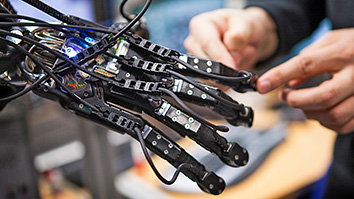
Radio processors will be needed in communication environments where static solutions often fail.
The world is crowded with commercial and military devices that communicate wirelessly. The skies, too, have grown crowded as those devices compete for limited radio spectrum. Unregistered drones use unlicensed Wi-Fi to communicate; radar signals interfere with Wi-Fi signals, and so on. This reality has given rise to “reconfigurable radios” that change communication channels and patterns on the fly to avoid interference.
“Autonomous radios” present a security challenge to effective spectrum monitoring, producing a need for equally adept radio frequency (RF) processors that can spot real-time changes in a wide spectrum full of complicated signals and can detect and track new signals and their sources.
To date, no such devices have been developed that are up to the challenge, but a team of researchers at SRI and collaborators at the University of California, Davis and California State University Fresno, recently received a multi-year award from the Defense Advanced Projects Agency (DARPA) to develop a Runtime Reconfigurable Cognitive Spectrum Processor (R2CSP) under the Processor Reconfiguration for Wideband Spectrum Sensing (PROWESS) program.
“R2CSP will use AI to interpret radio spectrum and adapt to rapidly changing environments,” said David Zhang, SRI’s principal investigator on the project. “This will provide unprecedented situational awareness in complex and uncertain environments that are critical in radar and electronic communication.”
The team’s goal will be to develop reconfigurable processors able to sample wideband radio spectrum, overcome potential interference, differentiate agents communicating on shared spectrum, delineate important signals from insignificant ones, and reconfigure running tasks within 50 nanoseconds — fast enough to process hundreds and thousands of signals at any given time.
“We think of this as a computational reflex mechanism able to redeploy programs and reallocate resources.” – David Zhang
These new radio processors, Zhang says, will be needed in our crowded, complex, and uncertain military and civilian communication environments where static, pre-programmed solutions often fail. Existing systems are “hardware-defined” — unswitchable when RF signal environment changes.
R2CSP is fast task-switchable and thus able to reprogram quickly with the help of AI. “We think of this as computational ‘reflex mechanism’ able to redeploy programs and reallocate resources almost instantaneously and respond to changes in the RF environment, which could include jamming, frequency hopping, or other adversarial attacks,” Zhang says.
In technical terms, R2CSP will unite high-density reconfigurable processing arrays with real-time schedulers to deliver ultrafast switching and high-density computing. Computationally, SRI and collaborators will take advantage of an approach known as multiple-instruction-multiple-data (MIMD) processing that can spread the complex mathematical demands of this work across a thousand or more compute cores working in parallel, each of which can be switched quickly based on the requirement. The research team anticipates using AI to analyze spectrum to help distinguish significant from insignificant RFs to slash computational time expended scanning irrelevant signals.
“Radio autonomy is a complex challenge, but also an exciting and important one to work on,” Zhang says, sizing up the work ahead.
This material is based upon work supported by the Defense Advanced Research Projects Agency (DARPA) under Contract No. HR001123C0100. Any opinions, findings and conclusions or recommendations expressed in this material are those of the author(s) and do not necessarily reflect the views of the Defense Advanced Research Projects Agency (DARPA).
Learn more about our innovations in security.



